Synopsis: effera™ is the first human-equivalent lactoferrin ingredient for dietary supplements and functional foods, developed through a precision fermentation process by a nutrition biotechnology startup named Helaina.
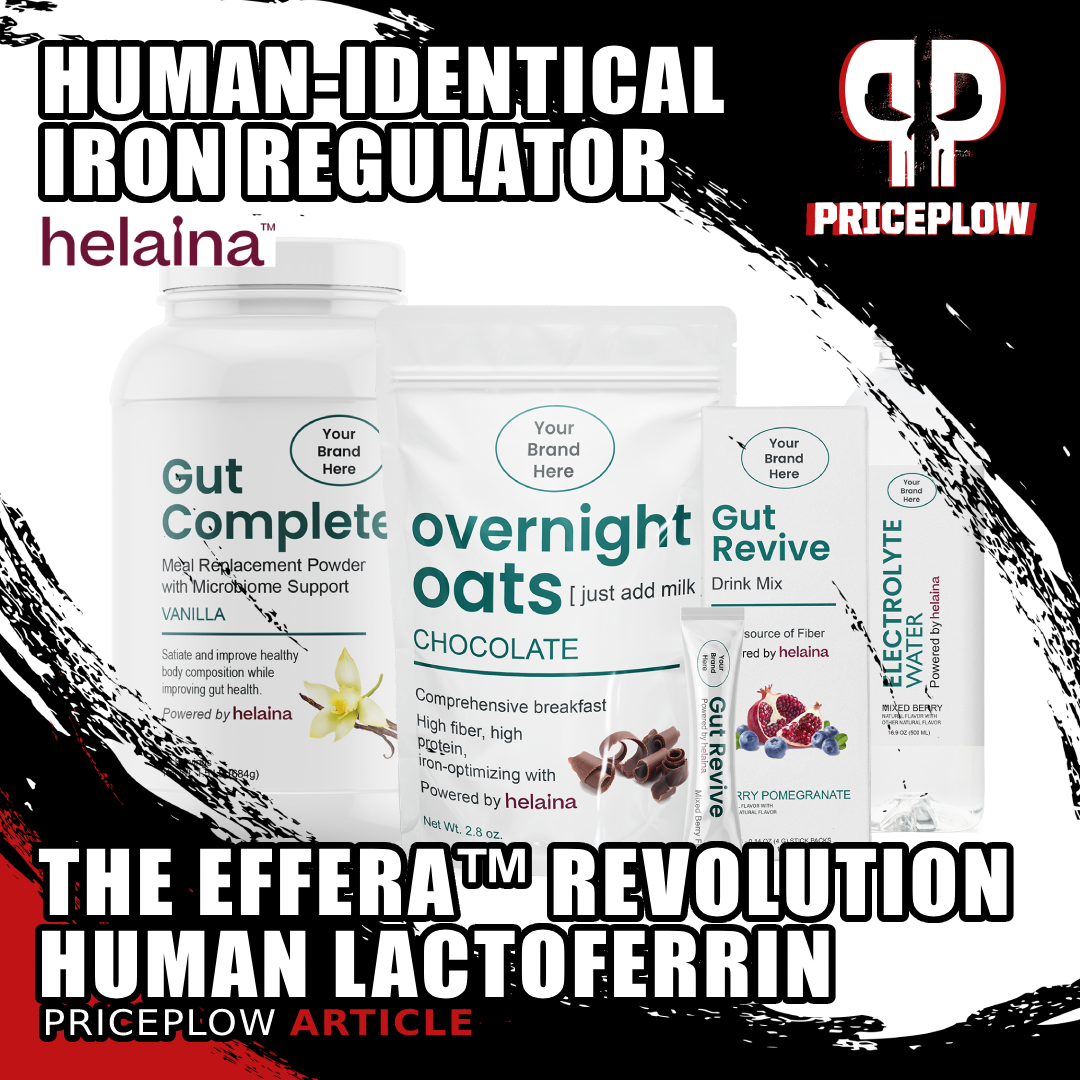
Helaina's effera™ is revolutionizing supplements with the first human-equivalent lactoferrin. Research shows better bioavailability and reduced immune response compared to bovine sources.
Research shows it's more bioavailable than bovine lactoferrin, has reduced allergenic potential (free of the 9 major allergens), and is recognized by the body as native human lactoferrin, unlike bovine lactoferrin. Because effera™ is structurally identical to native human lactoferrin, it offers the potential for superior benefits with lactoferrin's key uses, which include iron regulation, immune function, gut health, and beyond.
What is effera™?
If you follow the dietary supplement industry, you may have noticed that there's a revolution under way: the use of precision fermentation to produce ultra-pure compounds that mimic exactly what is found in nature, with virtually no byproducts or solvents inside. This technology has been used in the enzyme industry for years, and has now made its way into supplements. These innovations -- compounds that truly mirror what the body produces naturally -- are rare. So when we say a revolution is underway in the world of biological proteins, we mean it.
Enter effera™ - the first commercially available human-equivalent lactoferrin ingredient, developed by Helaina specifically for dietary supplements and functional foods.
A Brief Introduction to Lactoferrin
Lactoferrin is a multifunctional iron-binding glycoprotein produced by numerous cells throughout the body and found abundantly in human milk and other secretions including saliva, tears, and gastrointestinal fluids. It's long been recognized for its critical roles in iron regulation, immune function, and gut health. Until now, supplement formulators have relied primarily on bovine lactoferrin (extracted from cow's milk), which differs significantly in structure and function from the lactoferrin naturally found in the human body.
effera™ changes everything, and we're only witnessing the start of this revolution.
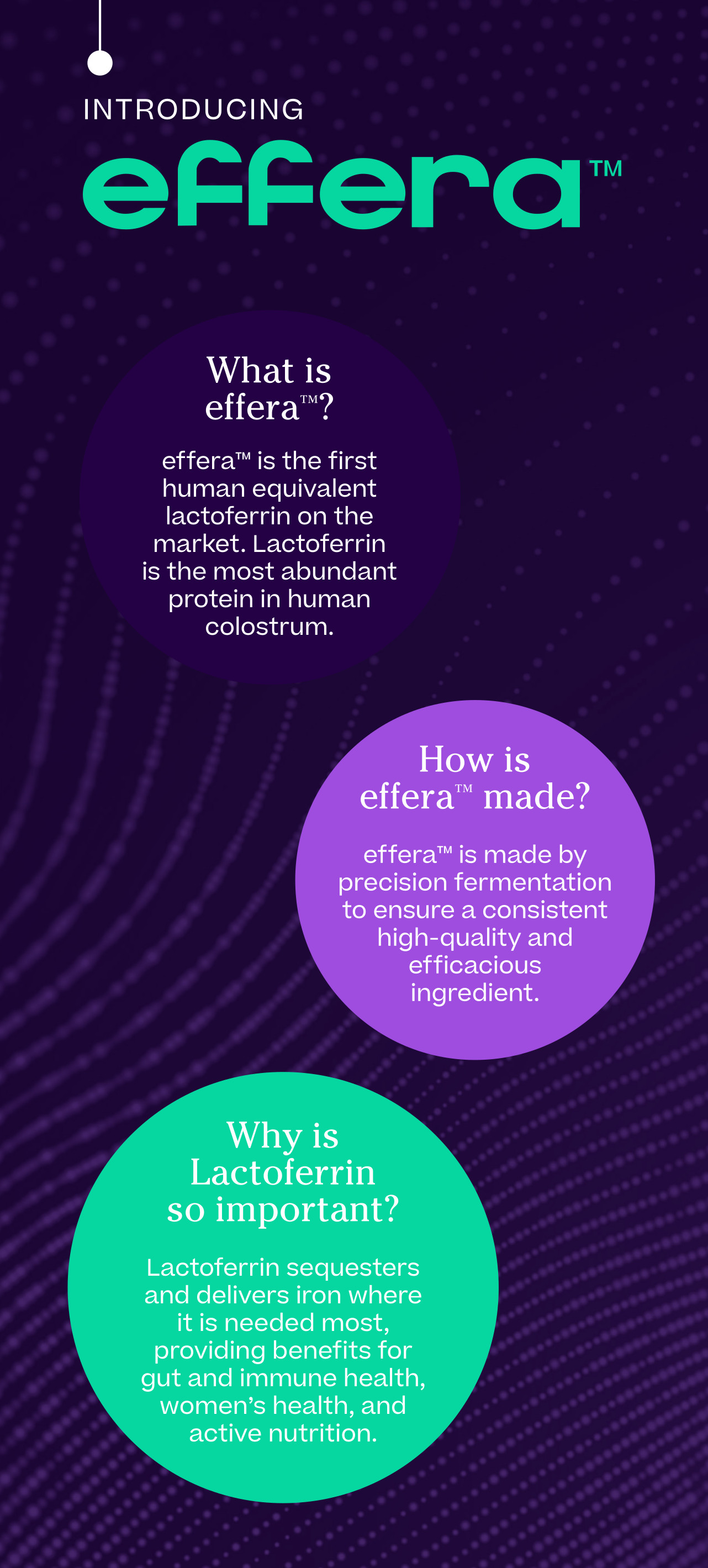
This informative infographic explains the core aspects of effera™ - what it is (the first human-equivalent lactoferrin), how it's made (through precision fermentation for consistent quality), and why lactoferrin matters (for its ability to regulate iron and support gut health, immune function, women's health, and active nutrition).
Using breakthrough precision fermentation technology, Helaina has created a lactoferrin that's structurally identical to human lactoferrin, with the same amino acid sequence and similar glycosylation patterns.[1] This isn't just another supplement ingredient... it's a paradigm shift in bioactive protein supplementation.
Since you're going to be hearing a lot about this over the coming years, it's best to start understanding it right now. This article is the first of many deep-dives into this fascinating technology, with implications that we're only beginning to understand.
A Story That Begins with an Unexpected Twist
Helaina's existence isn't just some standard biotech story, though. The innovation behind effera™ was actually sparked by a concerning discovery made by their founder, Laura Katz: The existence of a black market for breast milk, highlighting a desperate demand for human bioactive proteins that were previously inaccessible. She founded Helaina in response, with the goal to develop technology that could make these valuable compounds available ethically and at scale, without compromising on quality or function.
Clinical research now confirms what theory predicted: effera™ demonstrates superior digestive stability, reduced immunogenicity, and greater bioavailability compared to bovine lactoferrin.[2] With applications spanning women's health, active nutrition, healthy aging, and gut support, effera™ represents the next generation of lactoferrin supplementation.
Before we dig deeper, sign up for PricePlow's news alerts to stay updated on Helaina and effera™, and be the first to know about new products featuring this groundbreaking ingredient:
Subscribe to PricePlow's Newsletter and Alerts on These Topics
It's important to understand lactoferrin itself before getting into the effera™ difference. If you're already familiar with lactoferrin, you can briefly scan this area and skip down to the next section. Below is a general lactoferrin recap:
What is Lactoferrin?
Lactoferrin (LF) is a remarkable iron-binding glycoprotein that belongs to the transferrin family and has earned the nickname "miracle molecule" from some researchers for its wide range of biological activities.[3] It was first discovered in milk in the 1930s, and is a multifunctional protein that plays essential roles in human health from infancy through adulthood. It's available in mammal milk, with each mammal having a different type of lactoferrin.
Structure and Forms
Lactoferrin consists of a polypeptide chain folded into two symmetrical lobes (N and C), each capable of binding one iron ion (Fe³⁺) with remarkable strength.[3] Its iron-binding capacity is approximately 260 times stronger than that of transferrin, the primary iron transport protein in blood.[4] When it comes to iron-binding, lactoferrin is king.
In the body, lactoferrin exists in three main forms:[5]
- Apo-lactoferrin: The iron-free form
- Holo-lactoferrin: The iron-saturated form
- Native lactoferrin: The partially saturated form (usually 15-20% saturated)
The structure of lactoferrin, including its glycosylation pattern (attached sugar chains), directly influences its stability, receptor binding ability, and biological functions.
Distribution in the Body
Lactoferrin is most abundant in mammalian milk (especially in colostrum, the first milk produced after birth), but is found throughout the human body:[6]
- Milk: Human colostrum contains 6-7 g/L, decreasing to 1-2 g/L in mature milk
- Body fluids: Present throughout life in tears, saliva, nasal secretions, gastrointestinal fluids, and urine
- Immune cells: Stored in neutrophils and released in cases of inflammation
- Tissues: Found in the kidneys, lungs, liver, pancreas, intestines, and reproductive organs
Lactoferrin concentrations vary significantly between species. Human milk contains much higher levels than cow's milk (0.1-0.3 g/L), while rat milk completely lacks lactoferrin.[6]
Key Biological Functions
A section on lactoferrin's research-backed benefits comes later in this article, but below are some of its main functions:
-
Iron Regulation and Metabolism
Lactoferrin's primary role is regulating iron availability in the body. By binding and sequestering iron, it:[5]
- Prevents excess free iron from catalyzing harmful oxidative reactions
- Makes iron unavailable to pathogenic bacteria that require it for growth
- Helps maintain iron homeostasis
- Facilitates controlled iron absorption in the intestine
Because of this, lactoferrin should be considered alongside direct iron supplementation, and possibly even in lieu of it (with the support of blood work and a doctor's care). Unlike traditional iron supplements that can cause GI distress, lactoferrin mediates iron delivery in a controlled manner, potentially making it a more effective option for addressing iron needs.[7] The body may actually have enough iron stored in the liver, it may just need support transporting it.
-
Antimicrobial Defense
Lactoferrin serves as a natural antimicrobial through several mechanisms:[4]
This image highlights effera™'s unique position as the first human-equivalent lactoferrin ingredient commercially available. Unlike bovine lactoferrin, which shares only 70% amino acid sequence identity with human lactoferrin, effera™ delivers the benefits of being clinically studied, vegan (eliminating dairy allergen concerns), and non-allergenic.
- Creating an "iron starvation" effect for pathogens
- Directly binding to bacterial cell surfaces, disrupting their membranes
- Preventing formation of bacterial biofilms
- Blocking viral attachment and entry into host cells
These properties make lactoferrin an important component of the body's first-line defense against infections, and we foresee its use in more immune system support supplements, which is covered in the Applications section of this article.
-
Immune System Modulation
Further, lactoferrin interacts extensively with the immune system by:[6]
- Stimulating natural killer (NK) cells and macrophages
- Influencing T-cell and B-cell development
- Balancing pro- and anti-inflammatory cytokine production
- Enhancing intestinal immune function
This immunomodulatory capacity allows lactoferrin to both enhance immune responses when needed and reduce excessive inflammation.
-
Gut Health
In the digestive tract, lactoferrin:[4]
- Promotes growth of beneficial bacteria like Bifidobacterium and Lactobacillus
- Inhibits pathogenic bacteria
- Enhances intestinal cell proliferation and maturation
- Strengthens the intestinal barrier
- Supports gut repair after injury
However, not all lactoferrin molecules are the same. It's important to note that human and bovine (cow) lactoferrin share only about 70% amino acid sequence identity, with differences in glycosylation patterns that affect their biological activity.[7] While bovine lactoferrin has demonstrated benefits in numerous studies, human-identical lactoferrin may offer even more advantages in terms of receptor binding and bioavailability.
This is where Helaina's expertise comes in, and that brings us to our next section:
Human vs. Bovine Lactoferrin: Key Differences
Lactoferrin is found across mammalian species, but significant structural and functional differences exist between human lactoferrin (hLF) and bovine lactoferrin (bLF). These differences help explain why effera™ human equivalent lactoferrin may offer superior benefits compared to standard bovine lactoferrin supplements.
Structural Differences
Human and bovine lactoferrin share approximately 69% amino acid sequence identity, with both proteins containing around 690 amino acids.[1,7] Despite this similarity, the structural differences profoundly affect how each interacts with the human body:
- Amino Acid Sequence: Human lactoferrin contains 691 amino acids,[1] while bovine lactoferrin has 689.[8][3] These small differences in sequence contribute to changes in protein folding and receptor binding.
- Glycosylation Patterns: The sugar structures (glycans) attached to lactoferrin differ significantly between species. Human lactoferrin contains primarily complex N-glycans and 3 glycosylation sites, while bovine lactoferrin contains a mix of oligomannose and hybrid glycans and 5 glycosylation sites.[1,9,10]
This is important because glycosylation affects protein function, stability, and interactions with receptors in the body.[11]

Laura Katz founded Helaina after learning of the black market for human breast milk and realizing how demand for human proteins could be satisfied using novel technology
Functional Differences
The structural differences between human and bovine lactoferrin translate to important functional differences in how they interact with the human body:
-
Receptor Binding and Recognition
The human body has specific lactoferrin receptors (LFRs) that recognize and bind human lactoferrin[12] with greater efficiency than bovine lactoferrin:
- Human lactoferrin is recognized as "native" by the body's lactoferrin receptors
- Human lactoferrin binds more efficiently to these receptors due to its precise structural configuration
- Bovine lactoferrin, with only 70% homology to human lactoferrin, demonstrates reduced binding affinity to human receptors
As noted by Helaina in their literature, "There are specific gut receptors that recognize human lactoferrin, facilitating its uptake into the bloodstream. This process is crucial for lactoferrin to exert its beneficial effects."
-
Digestive Stability
Human lactoferrin tends to survive longer in the human digestive tract:
- Digestion Studies: Helaina's internal in vitro digestion research revealed that human lactoferrin (and effera™) remained intact for approximately 10 minutes in simulated gastric conditions, while the same dosage of bovine lactoferrin was digested almost immediately.[11]
- Proteolytic Resistance: The glycosylation patterns on human lactoferrin help protect it from digestive enzymes,[1] allowing it to remain bioactive longer in the GI tract.
This superior digestive stability contributes to greater bioavailability, as intact lactoferrin is more likely to be absorbed and exert its beneficial effects throughout the body.
-
Immune System Response
A critical difference between human and bovine lactoferrin is how the body's immune system responds to each:
- Antibody Development: Clinical research with effera™ showed that human lactoferrin is recognized by the body as native, with no antibodies developed against the protein. In contrast, bovine lactoferrin supplementation resulted in the development of anti-bovine lactoferrin antibodies.[2]
- Immune Tolerance: The body naturally tolerates human lactoferrin as "self", while bovine lactoferrin may trigger an immune response as "non-self".
- Efficacy Implications: When antibodies develop against bovine lactoferrin, they can potentially clear the protein before it exerts its full benefits, similar to what occurs with certain biologics where efficacy decreases over time due to immune response.
Unlike bovine lactoferrin that requires approximately 10,000 liters of cow's milk to produce just 1 kilogram, effera™ utilizes precision fermentation technology to create a human-identical protein. This sustainable manufacturing process ensures consistent quality without the variability or resource intensiveness of animal-sourced ingredients.
With better "acceptance" of the human lactoferrin, effera™ theoretically leads to improved benefits with respect to its main functions, including iron regulation and microbiome health. Those benefits are discussed in detail below.
Supply Chain Considerations
Beyond biological differences, it's important to note the differences between procuring bovine and human-equivalent lactoferrin:
- Extraction Efficiency: According to Helaina's literature, industry requires approximately 10,000 liters of cow's milk to produce just 1 kilogram of bovine lactoferrin, making its supply chain resource-intensive, expensive, and variable.
- No Heat Treatment: Many milk-derived lactoferrin ingredients come from pasteurized milk, which means they've been heat-treated. The pasteurization process dramatically affects lactoferrin retention,[13,14] and may alter the protein as well.
- Consistency: Proteins sourced from milk can vary significantly in quality and composition based on the cows' diet, health, and environmental factors.
- Scalability: effera™ human-equivalent lactoferrin is produced through precision fermentation technology, a scalable manufacturing process that removes the need for animal sources while providing consistent supply and reproducible quality.
Clinical Implications
The physiological differences between human and bovine lactoferrin translate to potential clinical advantages for human-equivalent lactoferrin supplementation:
- Enhanced Bioavailability: Due to better receptor binding and increased digestive stability
- Lower Allergenic Risk: As the body recognizes human lactoferrin as "self" -- effera™ has no lactose, unlike bovine lactoferrin extracts that may still contain it milk sugar
- Adaptive Nutrient Capability: Human lactoferrin may better adjust its actions based on the body's changing needs
The evidence suggests that while bovine lactoferrin offers numerous benefits -- both for health and for industry sustainability. effera™ may provide superior bioactivity, especially for applications where optimal receptor binding, extended digestive survival, and reduced immune recognition are desired.
Let's dive deeper into the research Helaina has conducted specifically on effera™ at the time of publishing:
Clinical Evidence: effera™ in the Research
It's early, and Helaina has already invested a lot into scientific research to evaluate effera™ compared to bovine lactoferrin. It starts with evidence showing that it demonstrates superior performance:
Breakthrough Clinical Trial: No Immunogenicity Response
In a landmark randomized, double-blind, controlled trial published in 2024, researchers directly compared effera™ with bovine lactoferrin to assess their immunological effects in healthy adults.[2]
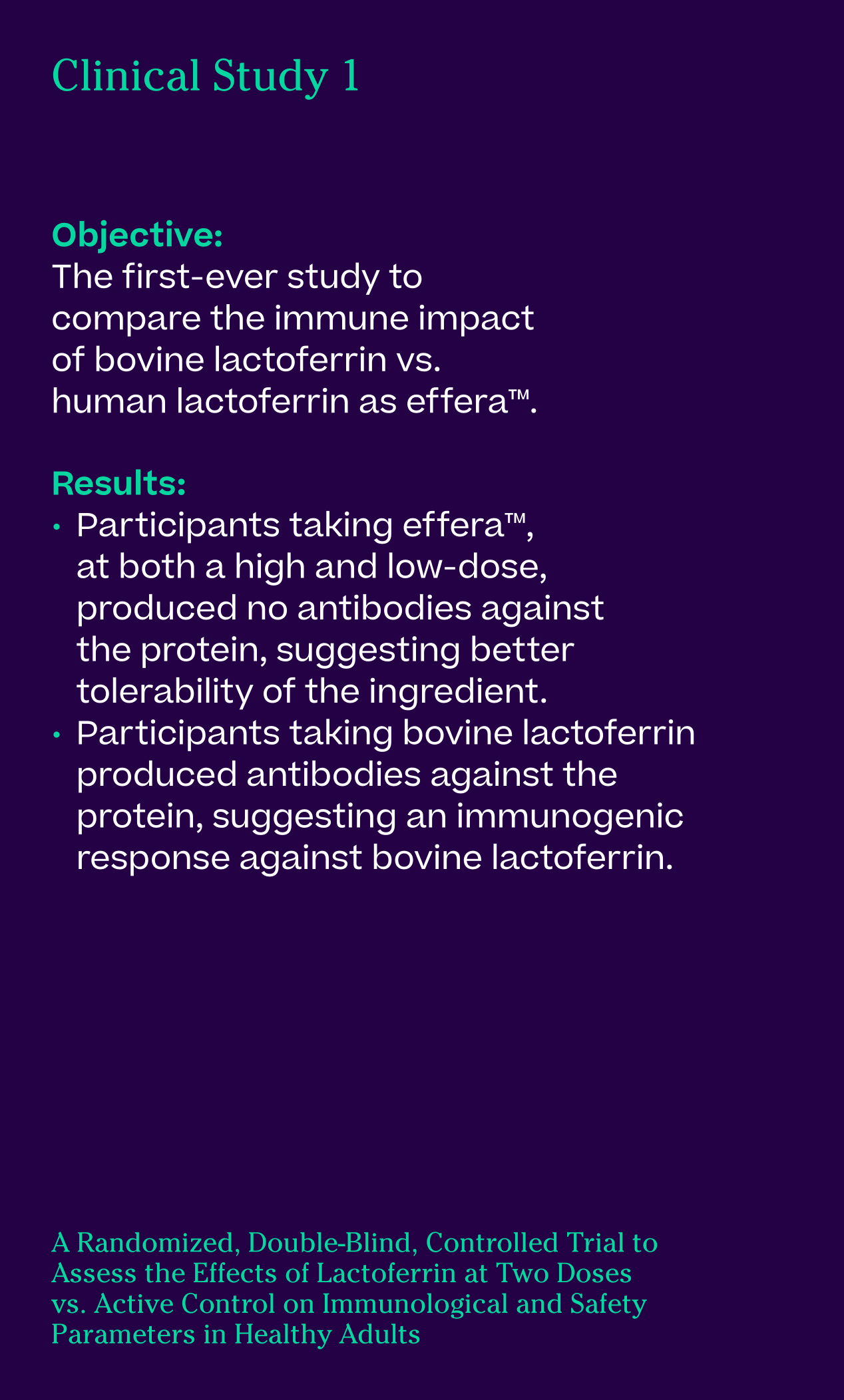
The landmark clinical trial showed participants taking effera™ produced no antibodies against the protein, while those taking bovine lactoferrin developed antibodies - demonstrating effera™'s superior biocompatibility with the human immune system.[2]
This 84-day study followed 66 healthy adults randomly assigned to three groups:
- High-dose effera™: 3.4g/day
- Low-dose effera™: 0.34g/day
- Bovine lactoferrin: 3.4g/day (active control)
The results revealed a striking difference in how the body responded to each form of lactoferrin:[2]
- Bovine lactoferrin group: Participants developed antibodies against the protein, with antibody levels approximately 3 times higher after 56 days compared to baseline
- Both effera™ groups: No significant increase in anti-human lactoferrin antibodies at either dose level!
This absence of antibody response to effera™ suggests that the body recognizes it as "self", treating it as native human lactoferrin rather than as a foreign protein requiring immune surveillance. This finding has profound implications for supplement efficacy and for the supplement industry at large.
When antibodies develop against a supplemented protein (as seen with bovine lactoferrin), they can potentially neutralize or clear that protein before it exerts its full beneficial effects. This phenomenon is well-documented with certain biologic medications where efficacy decreases over time due to antibody development.
The researchers concluded that effera™ demonstrated "low immunogenicity/alloimmunization potential", meaning it's less likely to trigger the immune system to develop antibodies against it. This is a critical safety consideration for any protein supplement.
Superior Digestive Stability and Bioavailability
To follow up, a 2024 study published in the journal Nutrients directly compared the digestion profiles of human milk lactoferrin, effera™, and bovine lactoferrin. This study provides insights into how each protein behaves in the digestive tract.[11]
Using analytical techniques that track the proteins through simulated gastric and intestinal digestion, researchers discovered:[11]
- Matching digestion patterns: effera™ and human milk lactoferrin demonstrated remarkably similar digestion profiles, with almost identical peptide release patterns
- Extended survival time: While bovine lactoferrin was rapidly degraded in simulated gastric conditions, both effera™ and human milk lactoferrin remained intact significantly longer
- Bioactive peptide production: Both effera™ and human milk lactoferrin released similar bioactive peptides during digestion, including those with antimicrobial and opioid antagonist activity
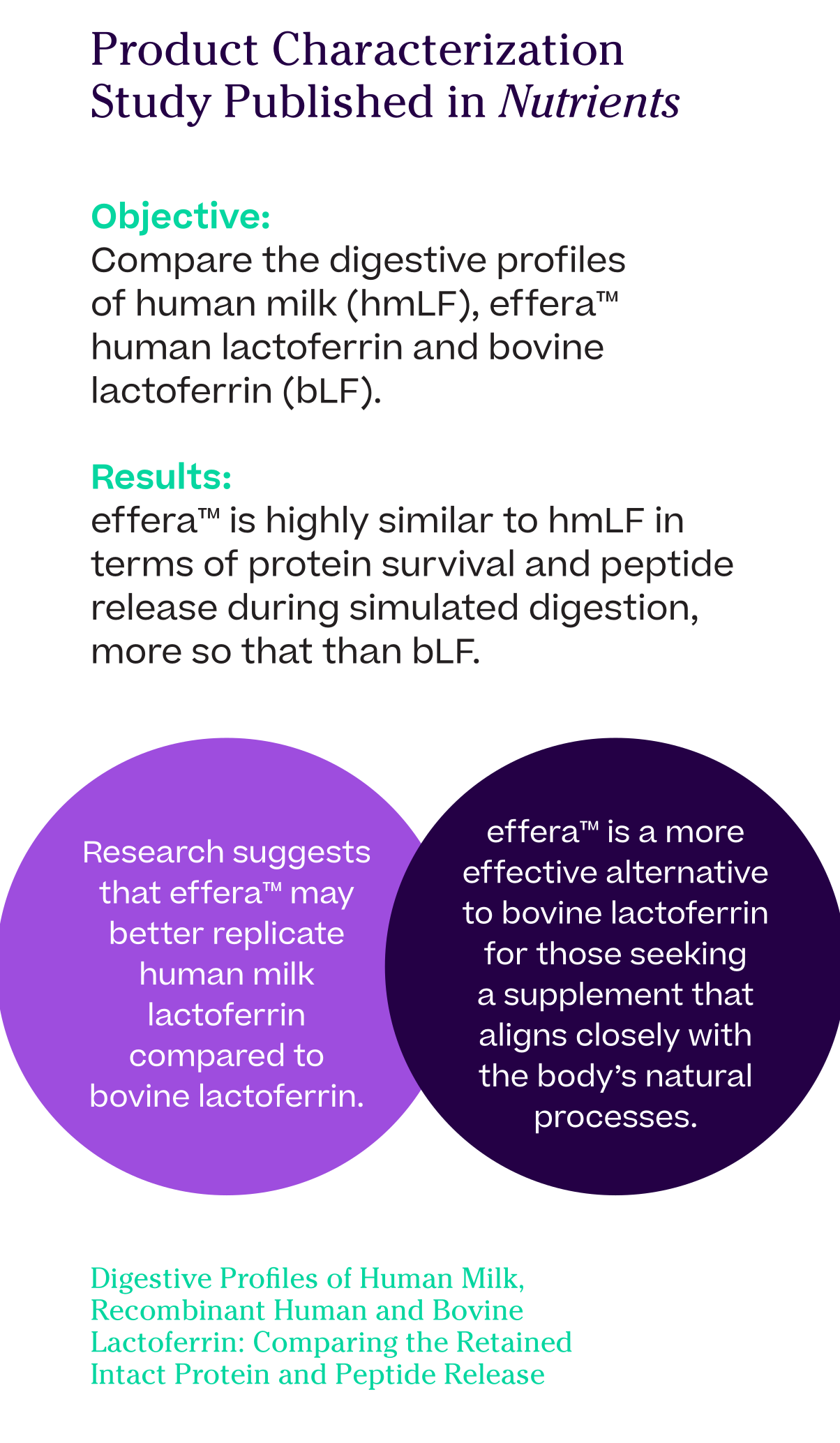
Research published in Nutrients confirms that effera™ closely mimics human milk lactoferrin's digestion profile, with better survival and similar peptide release patterns than bovine lactoferrin - suggesting superior bioavailability.[11]
This extended digestive stability is critical because intact lactoferrin has greater potential for absorption through intestinal receptors, while specific peptide fragments released during digestion have their own unique biological activities.
Gold Standard Immunotoxicity Assessment
Importantly, the same researchers from the 2023 landmark study conducted a comprehensive 28-day Good Laboratory Practice (GLP) immunotoxicity study in 2025.[9] This is the gold standard for assessing potential immune effects of a novel ingredient.
This study evaluated multiple dose levels of effera™ (200, 600, and 2000 mg/kg/day) compared to bovine lactoferrin (2000 mg/kg/day) in adult rats. The researchers used key immunological assessments:
- T-cell-dependent antibody response (TDAR)
- Comprehensive immunophenotyping of spleen cells
- Detailed organ weight analysis and histopathology
The results were definitive: "In all treatment groups, regardless of dose assignment, no significant adverse effects were observed for body weight, food intake, clinical observations, hematology, coagulation, clinical chemistry, urinalysis, toxicokinetics, and immunotoxicological (i.e., immunophenotyping and TDAR) outcomes."[9]
This GLP-certified study established a No Observed Adverse Effect Level (NOAEL) of 2000 mg/kg/day, which is roughly 400 times the estimated daily intake at the 90th percentile proposed for human adult use.
Effera's safety profile is covered in greater detail in a section below, but the above research indicating practically no immune response and a massive NOAEL is hugely important.
With that said, let's break into an overview of lactoferrin's benefits.
Lactoferrin Benefits: How effera™ Works in the Body
As a disclaimer, note that much of the research discussed below is based upon oral bovine lactoferrin supplementation. The data above suggests that effera™ should lead to even better outcomes, but given that the molecule is slightly different, more research on the ingredient specifically will need to be conducted.
-
Iron Regulation and Metabolism
As discussed in the introduction, lactoferrin is an iron-binding glycoprotein that plays a crucial role in iron homeostasis. It has the incredible ability to bind two ferric ions (Fe³⁺) per molecule with very high affinity.[15] Unlike transferrin, which releases iron at pH 5.5, lactoferrin can retain iron until pH values as low as 3.0, allowing it to function effectively even in acidic environments characteristic of infection and inflammation sites.[15]
A landmark clinical trial with pregnant women demonstrated lactoferrin's superior ability to increase hemoglobin and serum iron levels compared to traditional ferrous sulfate supplements. Remarkably, women receiving bovine lactoferrin (200 mg/day containing just 8.8 mg of iron) showed significantly greater increases in serum iron than those taking ferrous sulfate (520 mg/day containing 156 mg of iron), with the added benefit of no gastrointestinal side effects.[16]
Iron Regulation Mechanism
Lactoferrin's role in iron metabolism extends beyond simple iron binding, though. While initially thought to primarily sequester iron from potential pathogens, research now shows lactoferrin actively participates in regulating systemic iron distribution throughout the body.[17]
Iron homeostasis is tightly controlled through the interplay of proteins including ferroportin (the only known mammalian iron exporter from cells to blood), hepcidin (a hormone that regulates ferroportin), and certain inflammatory cytokines like interleukin-6 (IL-6).[15] Lactoferrin has been shown to modulate this entire system: it decreases IL-6 levels, which in turn affects hepcidin production and prevents ferroportin degradation, ultimately enhancing iron efflux from cells into the bloodstream.[18]
Clinical Efficacy vs. Traditional Iron Supplements
Unlike traditional iron supplements like ferrous sulfate, which can cause gastrointestinal discomfort, oxidative stress, and actually increase inflammation, lactoferrin regulates iron delivery in a more controlled and physiological manner.[19]
A large meta-analysis of clinical studies demonstrated that lactoferrin supplementation resulted in superior improvements in hemoglobin concentration, serum iron, and ferritin levels compared to ferrous sulfate supplements, despite providing substantially less elemental iron (approximately 70-84 μg/day from lactoferrin vs. 100+ mg/day from ferrous sulfate)![20]
The CONSORT diagram tracks how 84 assessed candidates were narrowed to 66 qualified participants divided into three groups: bovine lactoferrin control, low-dose effera™, and high-dose effera™ - following gold-standard clinical research methodology.[2]
This efficacy is unrelated to direct iron supplementation but is instead attributed to lactoferrin's ability to decrease inflammatory markers, helping to re-establish proper iron transport from cells.[17]
Anti-Inflammatory Mechanism of Iron Regulation
The emerging understanding is that lactoferrin doesn't simply treat iron deficiency by direct supplementation. Instead, it addresses the underlying condition of "iron delocalization", a situation where iron accumulates inside cells while remaining deficient in circulation.[19] By reducing inflammation (especially IL-6), lactoferrin prevents the downregulation of ferroportin, allowing iron to move from cellular stores back into circulation where it's needed.[18]
This mechanism explains why lactoferrin can effectively treat anemia of inflammation, a condition notoriously resistant to traditional iron supplementation therapy, and shows why lactoferrin represents a more physiological approach to addressing iron homeostasis disorders.[17]
Sometimes, after all, blood tests don't indicate total body stores -- there are cases of anemia where there's plenty of iron in the body, it's just not able to make it to circulation. In some cases, lactoferrin fixes this!
-
Gut Health and Microbiome Balance
It's not just about iron. Lactoferrin also plays a pivotal role in maintaining intestinal health and microbiome balance through multiple mechanisms. It has emerged as a promising gut integrity support compound for good reason, as it modulates the microbiome and protects against intestinal inflammation.
Bifidogenic Properties and Prebiotic Effects
One of lactoferrin's most well-documented effects is its ability to promote the growth of beneficial bacteria in the gut microbiome. It exhibits strong bifidogenic activity, selectively enhancing the growth of beneficial Bifidobacterium species.[21]
Research shows that bovine lactoferrin (bLF) and its peptides have varying effects on different species of Bifidobacterium, including B. breve and B. infantis, while human lactoferrin shows specific bifidogenic activity for B. bifidum.[21]
This schematic shows the structured approach for evaluating effera™ against bovine lactoferrin in two studies. Study 1 compared three treatment groups across 84 days, while Study 2 tracked participants without intervention - demonstrating the scientific rigor behind this revolutionary human-equivalent protein.[2]
These lactoferrin-binding proteins have actually been detected in several Bifidobacterium species, potentially explaining their growth response to lactoferrin exposure.[22]
Intestinal Barrier Protection
Lactoferrin significantly strengthens intestinal barrier integrity, a critical function for maintaining immune homeostasis and preventing toxin penetration and other microbial-related problems. It accomplishes this through several mechanisms:[20]
- Increasing transepithelial electrical resistance (TEER), a key measure of epithelial barrier tightness
- Decreasing paracellular permeability, which reduces the passage of potentially harmful molecules
- Upregulating the expression of tight junction proteins (claudin-1, occludin, and ZO-1) at both mRNA and protein levels
This barrier enhancement function has important implications for inflammatory bowel concerns and other conditions associated with intestinal permeability issues. For individuals with compromised gut barrier function, lactoferrin supplementation may offer incredible protective effects against pathogens and toxins that can get from the gut lumen into the bloodstream.[23]
Antimicrobial and Anti-Inflammatory Properties
Beyond its prebiotic effects, lactoferrin exhibits direct antimicrobial activity against various intestinal pathogens, as lactoferrin can disrupt bacterial cell membranes.[24] It can inhibit the growth of potential pathogens while sparing beneficial commensals:[24]
This diagram showcases lactoferrin's multifaceted intestinal benefits, from enhancing iron absorption and barrier function to modulating immunity and microbiota. These properties help explain why effera™ shows promise for comprehensive gut health support with its human-identical structure.[4]
- Reduces populations of Enterobacter and Klebsiella species
- Significantly diminishes pathogenic Staphylococcus species presence
Additionally, lactoferrin provides anti-inflammatory effects through the MAPK pathway, while attenuating inflammatory cytokine production.[25]
Clinical Applications and Benefits
The beneficial effects of lactoferrin on gut health have been observed in several clinical settings. In preterm infants, bovine lactoferrin supplementation promoted a healthier microbiome balance, with increased abundance of beneficial bacteria and reduced colonization by potential pathogens.[24]
Similarly, in pediatric patients undergoing chemotherapy, lactoferrin supplementation promoted gut microbiome eubiosis by:[26]
- Maintaining microbial diversity
- Preventing the overgrowth of Enterococcus
- Potentially reducing therapy-related complications
These findings highlight lactoferrin's potential as a nutritional intervention for supporting gut health in vulnerable populations and during treatments that typically disrupt the microbiome.
-
Immune System Support
Lactoferrin's multifunctional nature makes it valuable for healthy aging support. By helping moderate inflammatory responses, supporting immune function, and enhancing beneficial gut bacteria like lactobacilli and bifidobacteria, effera™ provides holistic benefits that address multiple aspects of health maintenance.
Lactoferrin stands out as a protein with profound implications for immune system function. Touched upon in the section above through its anti-inflammatory properties, it acts as a sophisticated immune modulator that helps the body maintain a delicate balance between fighting infections and preventing excessive inflammatory responses.[27,28]
Innate and Adaptive Immune Response Enhancement
One of lactoferrin's most impressive capabilities is its ability to simultaneously support both innate and adaptive immune responses. In the innate immune system, lactoferrin serves as a first-line defender in mucosal surfaces like the respiratory and gastrointestinal tracts.[29] Yet it can also stimulate the recruitment and activation of critical immune cells such as neutrophils, macrophages, and dendritic cells, which play crucial roles in identifying and eliminating potential pathogens.[27]
Antimicrobial and Antiviral Properties
Lactoferrin's immune-supporting capabilities extend to direct antimicrobial actions. The protein can:[30]
- Sequester iron, which limits bacterial growth
- Directly interact with bacterial cell membranes
- Disrupt viral entry into host cells
- Enhance the body's natural antiviral responses
Lactoferrin's potential against respiratory tract infections is especially pertinent this decade. Studies have shown it can help reduce the incidence of infections, especially in children and infants, by modulating immune responses and providing direct antimicrobial protection.[31]
Natural Immune Regulation
Lactoferrin also acts as an "immune sensor" by responding to the body's current immune status. This can both stimulate and suppress immune responses as needed, helping to prevent overactive inflammatory reactions while maintaining robust pathogen defense.[28]
Supporting Immune Cell Function
Research has demonstrated lactoferrin's potential to:[27]
- Increase natural killer (NK) cell activity
- Enhance the maturation of T and B lymphocytes
- Support cytokine production
- Improve overall immune cell responsiveness
Incredibly, these work throughout different life stages, in young and old humans.[31] This transitions us to the next section, where it especially applies:
-
Athletic Performance and Recovery
Recent research reveals lactoferrin's promising applications for athletes and physically active individuals. By supporting healthy inflammatory responses, maintaining optimal iron status for muscle growth and repair, and enhancing oxygen delivery through improved iron absorption, effera™ offers benefits beyond traditional iron supplements.
Less commonly known, lactoferrin actually offers significant benefits for athletes and physically active individuals! It plays crucial roles in exercise performance, recovery, and muscle development. These benefits extend beyond its iron-regulating properties, making it a potential new tool in sports and active nutrition.
But first, we do have to start with iron:
Enhanced Iron Utilization and Endurance
Athletes, especially endurance athletes, have heightened iron requirements due to increased oxygen demands during training. Research has shown that lactoferrin can help maintain optimal iron status in athletes, which is a critical factor for performance.[32]
In a landmark study with female long-distance runners, researchers found that athletes supplementing with lactoferrin alongside a low dose of iron maintained significantly higher red blood cell counts compared to those receiving only iron supplementation.[32] This is relevant because female athletes are at higher risk for iron deficiency, and a significant number of female athletes are likely affected.
This study demonstrated functional performance benefits, too: those taking lactoferrin experienced significantly lower blood lactate levels after a 3,000-meter running test compared to the control group.[32] This suggests that lactoferrin doesn't just help maintain iron status in lab tests, but actually enhances oxygen delivery to working muscles and improves metabolic efficiency during intense exercise.
Muscle Development and Hypertrophy
Beyond its iron-regulatory benefits, recent lab research has uncovered lactoferrin's direct impact on muscle tissue growth and repair. Studies using muscle cell cultures have demonstrated that lactoferrin promotes muscle cell proliferation, differentiation, and hypertrophy through a few different mechanisms.[33]
Mechanistically, the researchers found that lactoferrin stimulates the ERK1/2 signaling pathway in muscle cells, promoting their growth and development.[33] The study showed that lactoferrin increased the size of muscle fibers and enhanced the expression of muscle-specific proteins.
This muscle-building effect was further confirmed in a separate study using a knockout mouse model, where lactoferrin deficiency impaired the proliferation of satellite cells critical for muscle growth.[34]
Stacking with creatine?!
It gets even better. Recent groundbreaking research found an incredibly promising application: combining lactoferrin with creatine! In a 2024 study published in Nutrients, researchers found that this combination significantly improved muscle mass, function, and recovery in a sarcopenia model.[35] While the study was performed on mice and focused on age-related muscle loss, these are important implications for athletes looking to maximize muscle preservation and growth during intense training periods (or when recovering from injury).
While both lactoferrin and creatine individually provided benefits, their combination demonstrated the most significant improvements in muscle mass and function, with several pathways related to muscle protein synthesis and recovery targeted (including the mTOR pathway).[35] This synergistic effect leads us to believe that athletes may benefit greatly when adding lactoferrin to their stacks.
Ultimately, we'll need human clinical data here, but lactoferrin is a very promising ingredient for athletes concerned about maintaining iron status, without overdoing the iron supplements. This is an area on the leading edge, but we believe the following of benefits will be the next big thing for lactoferrin:
-
Women’s Health
Lactoferrin offers significant benefits for women, helping maintain healthy iron levels during menstruation, pregnancy, and menopause. Research also shows it can promote a balanced vaginal microbiome and support bone health in postmenopausal women - making effera™ a versatile supplement for women's wellness.
Lactoferrin offers significant benefits for women's health throughout various life stages, making it a unique and extraordinarily valuable supplement for female-specific concerns.
As discussed throughout this article, at its core, lactoferrin plays a crucial role in regulating iron homeostasis, which is especially important for women who experience regular iron loss due to menstruation.[36] Its iron-binding properties not only help women maintain proper iron levels, but do so without causing the uncomfortable digestive side effects associated with traditional iron supplements.[19]
Menstrual Health
For women experiencing menstrual discomfort, lactoferrin supplementation has demonstrated incredible effects. Studies show that bovine lactoferrin formulations can significantly improve psychological symptoms associated with menstruation.[37] Women receiving lactoferrin experienced reduced stress and improved parasympathetic nervous system activity during menses compared to those receiving placebo treatments.
Pregnancy Support
During pregnancy, lactoferrin offers many benefits for both mother and child:
- Supports proper iron utilization
- Reduces inflammation and oxidative stress, including in the amniotic fluid
- Modulates the immune system, as described above
- Supports healthy microbiota balance in the reproductive tract
This laboratory image shows conventional bovine lactoferrin powder extracted from cow's milk - the supplement industry's standard for decades. Unlike effera™, which is produced through precision fermentation to match human lactoferrin's structure, this powder requires approximately 10,000 liters of milk to produce just 1 kilogram of usable product.[7]
Research has shown that lactoferrin supplementation significantly increases hemoglobin and total serum iron in pregnant women compared to traditional iron supplementation.[17] Recall the landmark 2006 clinical trial on pregnant women discussed above, showing lactoferrin's ability to increase hemoglobin and serum iron levels better than ferrous sulfate.[16]
Follow-up research has confirmed lactoferrin's capabilities in high-risk pregnancies as well. In women with hereditary thrombophilia, lactoferrin not only improved hemoglobin and serum iron levels more effectively than ferrous sulfate, but also significantly decreased inflammatory markers and was associated with zero miscarriages compared to five miscarriages in the ferrous sulfate group.[38]
The above study touches upon its well-known anti-inflammatory properties, which may help reduce some pregnancy complications (by decreasing inflammatory markers like IL-6 and modulating the production of various cytokines).[39]
Further preclinical research highlights lactoferrin's potential in supporting pregnancy and early infant development. In a study examining intrauterine growth restriction (IUGR), maternal lactoferrin supplementation demonstrated remarkable protective effects.[40] While it did not alter overall gestational weight, it increased the birth weight of control pups by 4% and enabled IUGR pups to recover to a normalized weight by weaning. This suggests lactoferrin's potential to support optimal fetal growth and development.
Lactoferrin supplementation may also improve fertility in overweight females by reinforcing ovarian and uterine functions. In a recent 2022 preclinical study, lactoferrin ingestion reversed reduced litter size in overweight mice, normalized glucose concentrations, and suppressed overweight prevalence in offspring, suggesting potential benefits for women with overweight-related fertility challenges.[41]
Beyond growth, lactoferrin plays a crucial role in early developmental processes. Research reveals its ability to stimulate the proliferation and differentiation of small intestinal epithelial cells, directly impacting intestinal mass and digestive enzyme expression.[42] This is important for preterm infants, who have immature gastrointestinal systems and higher nutritional vulnerabilities.
This diagram shows how different concentrations of human lactoferrin affect intestinal development. The dual action - with higher concentrations promoting cell proliferation and lower doses enhancing differentiation - demonstrates lactoferrin's sophisticated biological role that effera™ aims to replicate.[4]
Other preclinical evidence also shows that lactoferrin protects the developing brain from neuronal injury, enhances brain connectivity, increases neurotrophin production, and decreases inflammation in models of perinatal inflammatory challenge and neonatal hypoxia-ischemia.[43]
Research also demonstrates that lactoferrin use during pregnancy shows promise for preventing preterm delivery and protecting fetal brain development. In one notable study, women at risk of preterm delivery who received vaginal tablets of lactoferrin (300 mg/day) exhibited reduced IL-6 levels in cervicovaginal fluids and increased cervical length compared to untreated women.[44]
While this wasn't technically used as a dietary supplement, it's still interesting and worth noting. This brings us to the next benefit:
Reproductive and Vaginal Health
Lactoferrin is naturally present in vaginal secretions and plays a key role in maintaining a healthy vaginal microbiome. Clinical research demonstrates that lactoferrin, when combined with probiotic strains, can effectively prevent recurrent bacterial vaginosis by promoting the growth of beneficial bacteria while inhibiting harmful pathogens.[45] The same benefits discussed in the gut health section aren't only in the gut, after all!
Bone Health in Postmenopausal Women
Maintaining bone health becomes increasingly important, especially as women age. Lactoferrin has shown excellent potential in this area, with studies indicating that it can positively affect bone turnover markers in postmenopausal women. Specifically, it has been observed to simultaneously reduce bone resorption markers while increasing bone formation markers.[46]
With its multifaceted benefits spanning from menstrual health to pregnancy support and postmenopausal bone maintenance, lactoferrin represents a uniquely valuable supplement option for women seeking natural support for their changing physiological needs across the lifespan.
effera™ offers a complete solution for women's wellness needs across all life stages. From supporting iron regulation and vaginal microbiome balance to promoting bone health and enhancing athletic performance, this human-equivalent lactoferrin addresses multiple female-specific health concerns with one bioidentical ingredient.
We foresee this as the next major application for lactoferrin -- which is more commonly found in gut health and immunity supplements. This brings us to the next section:
Applications and Dosing for effera™
Touched upon in the lactoferrin benefits discussion above, effera™'s versatility makes it suitable for various applications across different demographic groups:[17]
-
Women’s Health
-
Gut Health
-
Immunity
-
Healthy Aging
-
Active Nutrition
There's no "best fit", but with the research shown above, we believe that lactoferrin belongs in every supplement brand's arsenal -- the question is simply where and how they wish to employ it. But when it comes to which lactoferrin, Helaina makes a phenomenal case for effera™.
Formulation and Usage
effera™ is versatile and can be incorporated into various product formats, including:
- Capsules and tablets
- Powders and gels
- Energy drinks
- Nutritional bars
- Gummies
The recommended dosage of effera™ ranges from 100mg to 340mg per day, with different benefits observed at different dosage levels:
- 100mg/day: Supports a healthy immune system, gut health, iron levels, and recovery
- 200mg/day: All 100mg benefits plus maintained respiratory function and balanced gut microbiome
- 340mg/day: All previous benefits plus better-maintained iron homeostasis
Manufacturing, Safety, and Regulatory Status of effera™
When it comes to novel nutritional ingredients, safety is paramount. effera™ is Helaina's recombinant human lactoferrin (rhLF) produced via precision fermentation using Komagataella phaffii (formerly known as Pichia pastoris), a type of yeast commonly used for protein production. As this is a new ingredient produced with a different technology than standard bovine milk extraction, it has undergone extensive safety evaluation to ensure it meets the high standards required for food ingredients.
Comprehensive Safety Profile
Beyond just a study or two, Helaina has conducted a quite thorough safety assessment program for effera™, following recommendations from a scientific expert panel convened in 2023.[47] This assessment addressed key safety questions that had previously been unanswered for recombinant human lactoferrin, including:
- Immunogenicity/alloimmunization potential
- Immunotoxicity risk
- Effects on iron homeostasis
- Absorption, distribution, metabolism, and excretion (ADME) profile
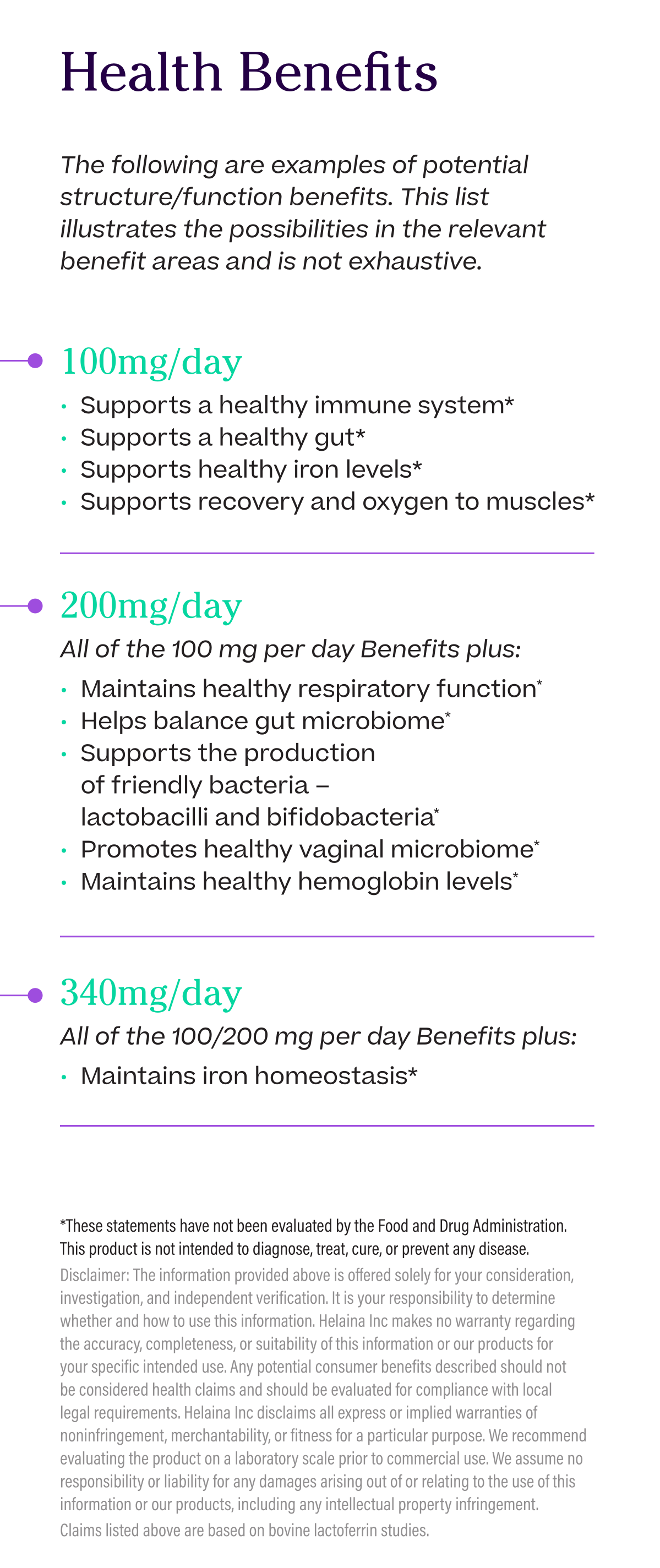
This informative chart outlines the progressive benefits of effera™ at three dosage levels. Starting with basic immune, gut, and iron support at 100mg daily, benefits expand to include respiratory function and microbiome enhancement at 200mg, with full iron homeostasis maintenance achieved at the clinical dose of 340mg daily.
Preclinical Safety Studies
In a 14-day dose range-finding toxicity study in rats, effera™ was well-tolerated at doses up to 2,000 mg/kg/day, which is about 57 times higher than the intended commercial use level for adults.[10]
This was followed by a more comprehensive 28-day GLP (Good Laboratory Practice) immunotoxicity study in rats that confirmed a No Observed Adverse Effect Level (NOAEL) of 2,000 mg/kg/day.[9] This study showed no toxicologically significant changes in any of the safety endpoints examined.
Clinical Safety Evidence
The ultimate test of safety comes from human studies. Described earlier in this article, a randomized, double-blind, controlled clinical trial evaluated effera™ at two dose levels (0.34 g/day and 3.4 g/day) compared to bovine lactoferrin (3.4 g/day) over 28 days in healthy adults.[2]
The clinical trial's primary endpoint addressed the immunogenicity potential of effera™, specifically whether it would trigger antibody production. Results showed no increase in anti-human lactoferrin antibodies with effera™ at either dose, while bovine lactoferrin did elicit antibody production.[2] Additionally, no significant adverse events were reported, confirming effera's safety profile in humans.
Regulatory Considerations
While bovine lactoferrin has achieved Generally Recognized as Safe (GRAS) status for various food applications, previous attempts to establish GRAS status for recombinant human lactoferrin were withdrawn from FDA review in the early 2000s due to unanswered safety questions.[48]
Helaina's comprehensive safety program for effera™ directly addresses these previously unanswered questions, establishing a solid foundation for regulatory acceptance. The recommended daily intake is 100-340mg per day, with specific structure/function benefits supported at different dosage tiers.
Allergenicity Assessment
As part of its safety evaluation, effera™ has undergone allergenicity risk assessment following Codex guidelines, including comparisons to known allergens and an evaluation of pepsin digestibility.[49] The conclusion was that effera™ has low allergenicity risk potential compared to known food allergens.
Helaina is doing things right -- a new ingredient deserves thorough research. effera™ is a significant advancement in providing a human-equivalent lactoferrin, and the company has addressed safety questions from regulatory authorities that were previously unanswered.
Initial Products Containing effera™
As more companies recognize the revolutionary potential of human-identical ingredients, we're beginning to see the first wave of products featuring effera™ hit the market. Let's examine one of these pioneering formulations:
-
Healthgevity’s immunoRESTORE+
Formerly known as "immunoREBOOT", Healthgevity's immunoRESTORE+ represents one of the first commercial supplements to harness the power of effera™ human-equivalent lactoferrin. This premium formula takes a comprehensive approach to microbiome balance, immune health, and iron optimization through a three-pronged strategy.
At its core is 340mg of effera™ human-equivalent lactoferrin, providing the clinically-supported dosage to maintain iron homeostasis while supporting gut and immune function. It's complemented by 1,000mg of 2′-FL (2′-fucosyllactose as GLYCARE®), the most abundant human milk oligosaccharide (HMO) that functions as a prebiotic to support gut health and immunity. Rounding out this science-backed formula is IMMUSE®, a postbiotic Lactococcus Lactis Strain Plasma that provides comprehensive immune support.
This professional-grade formula showcases how effera™ can be effectively combined with complementary ingredients to create a synergistic approach to health, targeting multiple benefits at once.
We expect to see additional products incorporating effera™ as formulators recognize its unique advantages and its potential applications across multiple health categories, including women's health, active nutrition, healthy aging support, and beyond.
Hear Directly from Helaina’s Founder: The PricePlow Podcast Deep Dive

Laura Katz, founder and CEO of Helaina, discusses the revolutionary effera™ human-identical lactoferrin technology and precision fermentation platform on Episode #167 of the PricePlow Podcast.
For those interested in learning more about the science and entrepreneurial journey behind effera™, we highly recommend listening to our in-depth conversation with Laura Katz, founder and CEO of Helaina, on Episode #167 of the PricePlow Podcast. In this fascinating discussion, Laura shares the surprising origin story of Helaina - beginning with her discovery of the black market for breast milk that inspired her to develop precision fermentation technology for human bioactive proteins.
The podcast recaps much of the above data but also includes some details not covered in this article, such as the technical challenges of spray-drying without carriers, the 98% purity achieved through their process, and exciting future applications in women's health and athletic performance. The conversation provides invaluable insights for formulators, researchers, and anyone interested in the cutting-edge science of human-identical nutrition.
Listen to the full episode: Laura Katz: Helaina Revolutionizes Nutrition with Human Identical Lactoferrin | Episode #167
Conclusion: The Future of Lactoferrin - and Dietary Supplements - Has Arrived
effera™ represents a true breakthrough in nutritional science: A human-equivalent lactoferrin produced through precision fermentation that mirrors what our bodies naturally recognize and utilize. As the first commercially available human-equivalent lactoferrin ingredient specifically designed for dietary supplements and functional foods, it stands to revolutionize how we approach iron regulation, immune support, gut health, women's health, and even athletic performance. It also showcases an ongoing revolution in the dietary supplement industry at large.
The evidence speaks for itself: effera™ demonstrates superior bioidentity, reduced immunogenicity, greater digestive stability, and enhanced bioavailability compared to traditional bovine lactoferrin. These advantages aren't just theoretical, either. They're backed by clinical research showing that effera™ is recognized by the body as "self", with no antibody development at doses 10 times higher than the recommended daily intake.
For supplement formulators, effera™ offers incredible versatility. Whether incorporated into capsules, powders, energy drinks, bars/foods, or gummies, this ingredient provides serious benefits at dosages as low as 100mg daily, with escalating advantages at 200mg and 340mg tiers. Its vegan-sourced, sustainable, and allergen-free profile makes it ideal for today's health-conscious consumers.
An Exciting Future Lay Ahead
But what's most exciting is what effera™ represents for the future. As one of the first human-equivalent bioactive proteins made widely available thanks to precision fermentation, it opens the door to an entirely new category of nutritional ingredients that work with our bodies in ways previously impossible to achieve at scale.
We have a feeling this isn't the only ingredient Helaina's going to come out with. More than just an ingredient, it's the vanguard of a nutritional revolution that merges cutting-edge biotechnology with our deepest understanding of human physiology. Between this technology and AI, things are going to get very interesting, very quickly.
Meanwhile, for consumers seeking the highest quality, most bioavailable form of lactoferrin to support their health goals, effera™ sets a new gold standard. Whether prioritizing women's health, immune function, gut integrity, athletic performance, or healthy aging, this breakthrough ingredient deserves consideration in any premium supplement regimen.
The future of lactoferrin has arrived, and it's a window into the future of the entire supplement industry. If effera™ is any indication, that future looks extraordinarily promising for all of us.
Stay tuned to PricePlow for the latest updates on this groundbreaking ingredient and the innovative products that will feature it in the months and years to come.

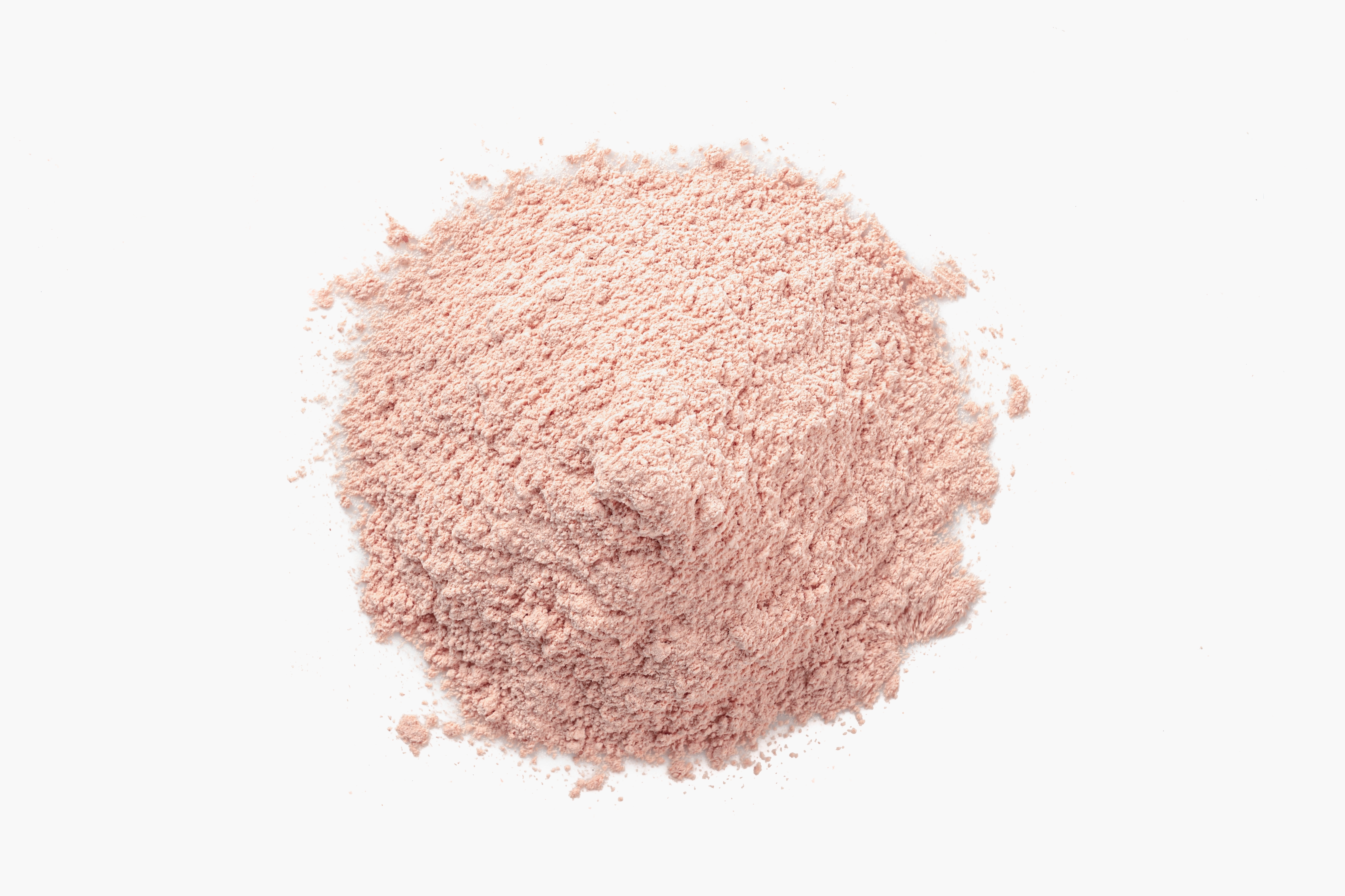
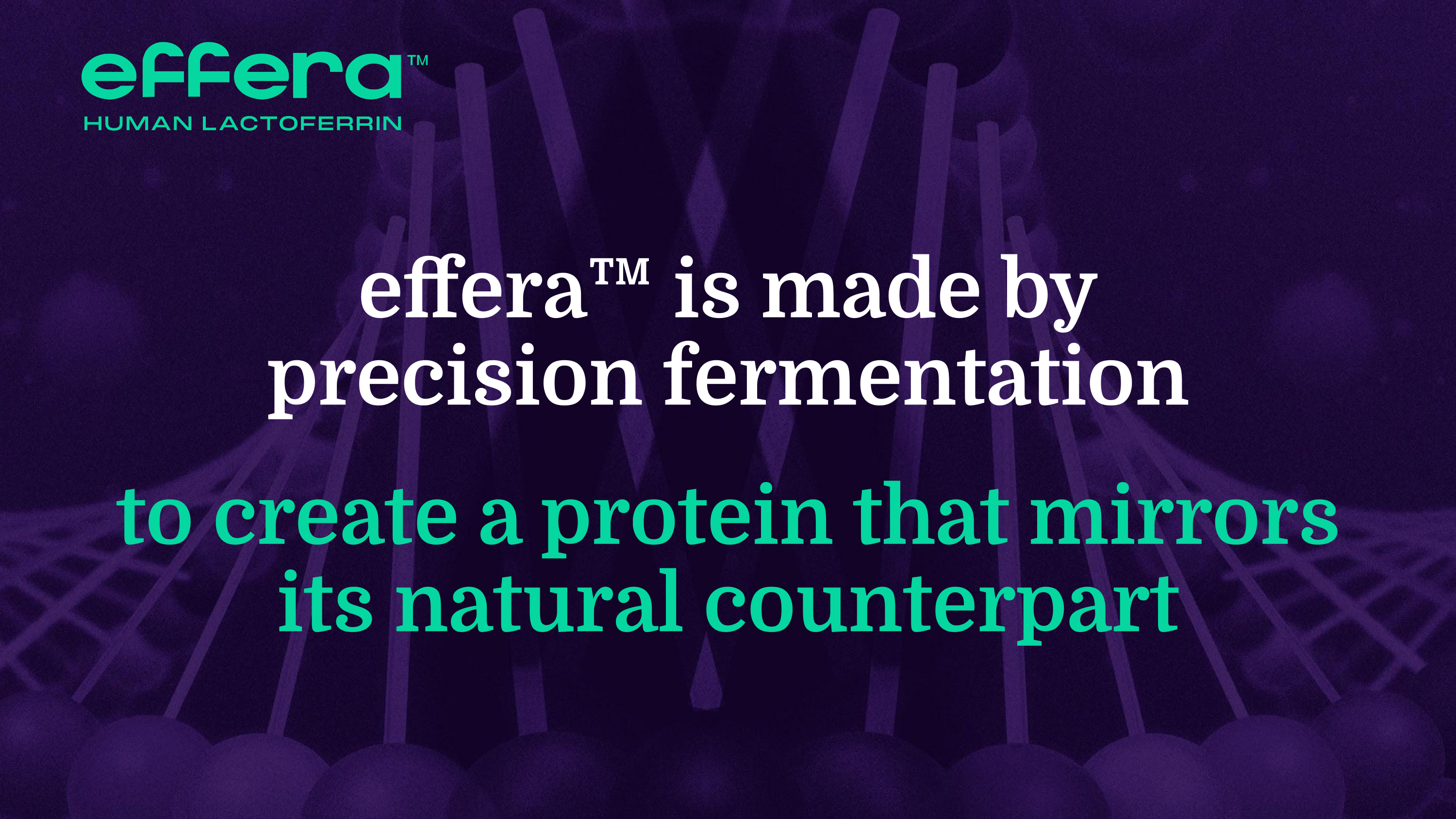

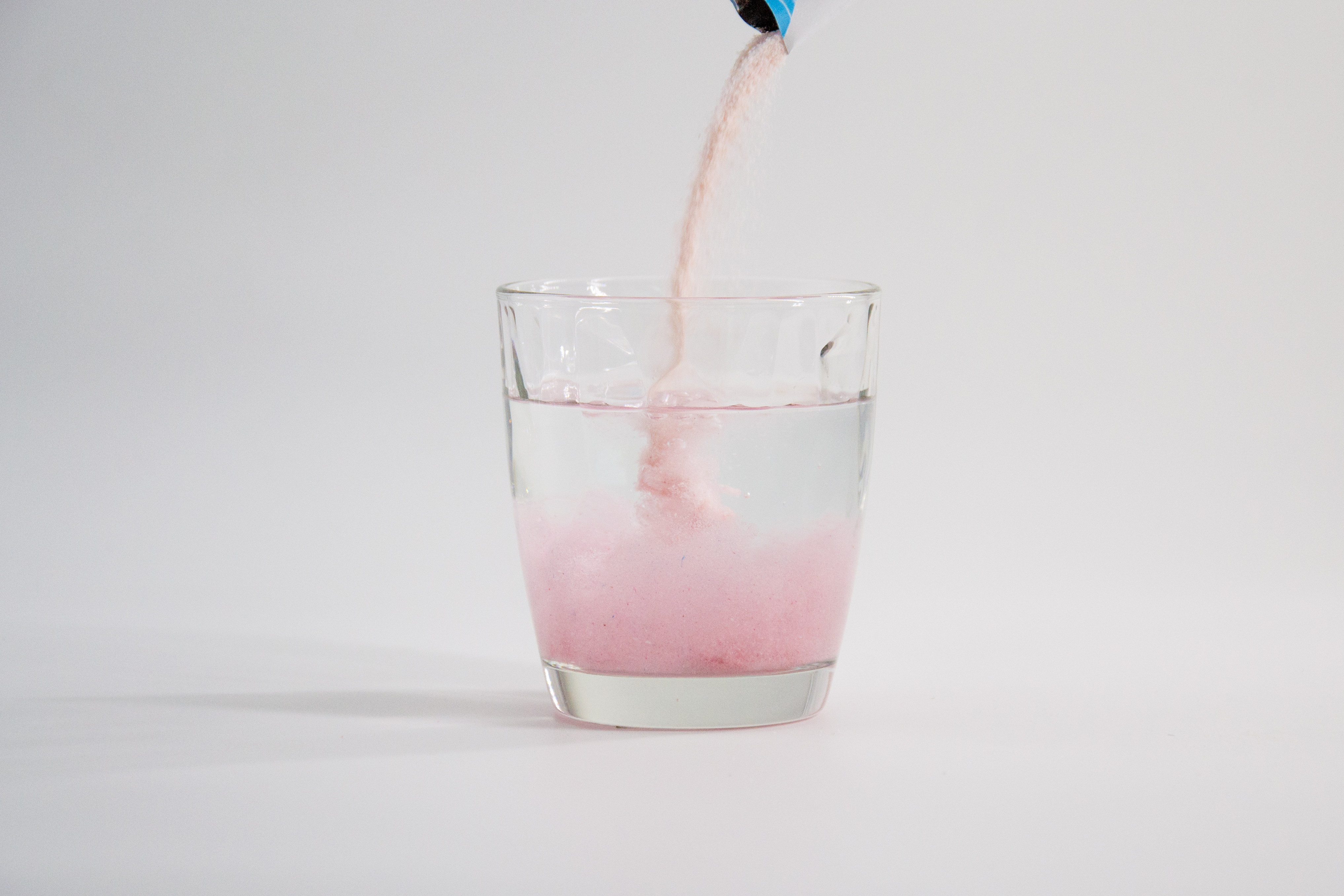
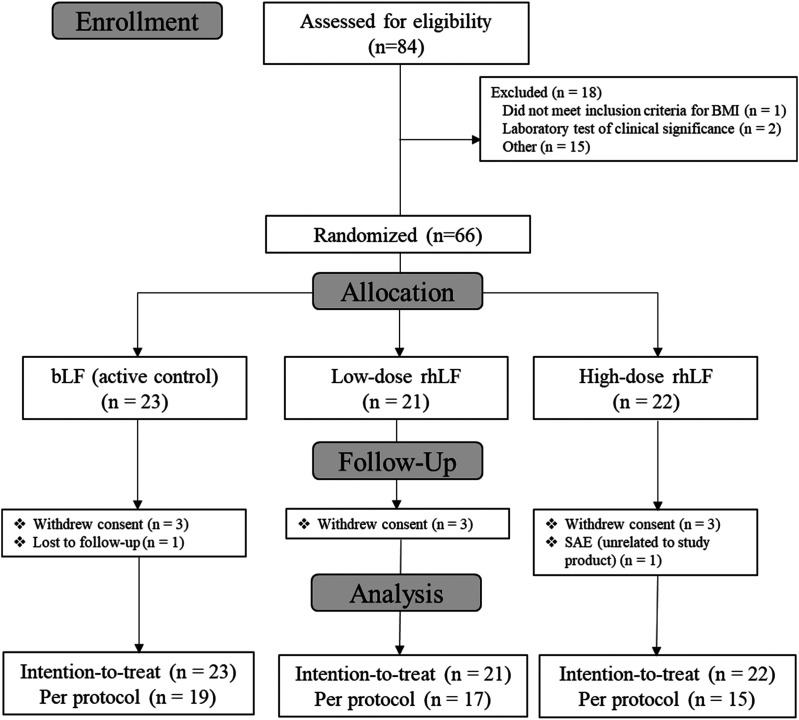
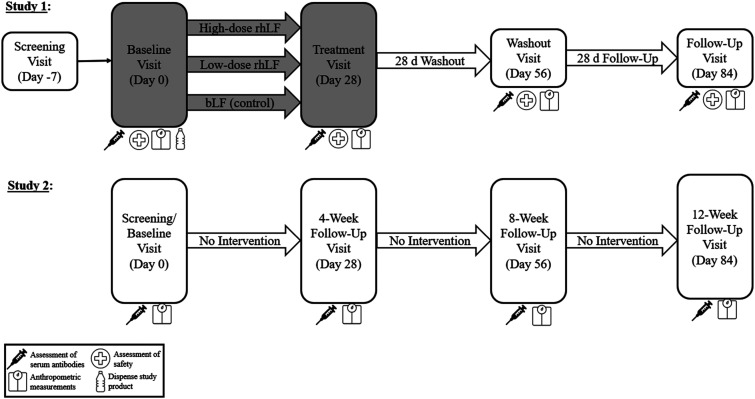
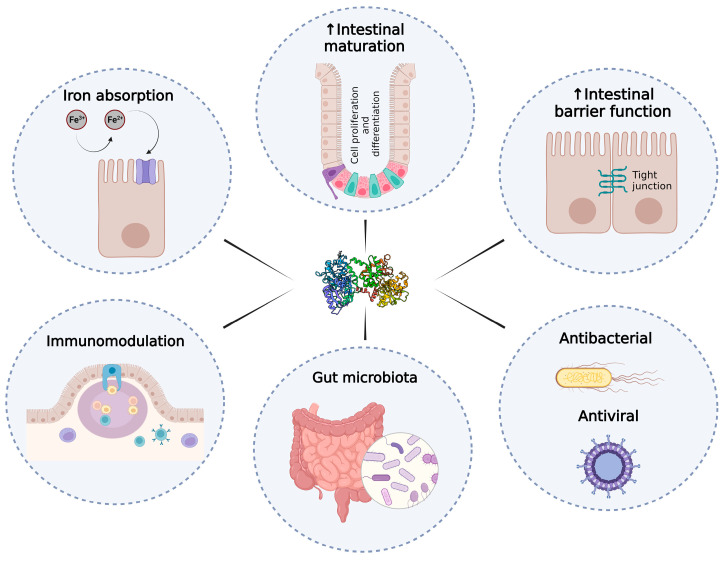

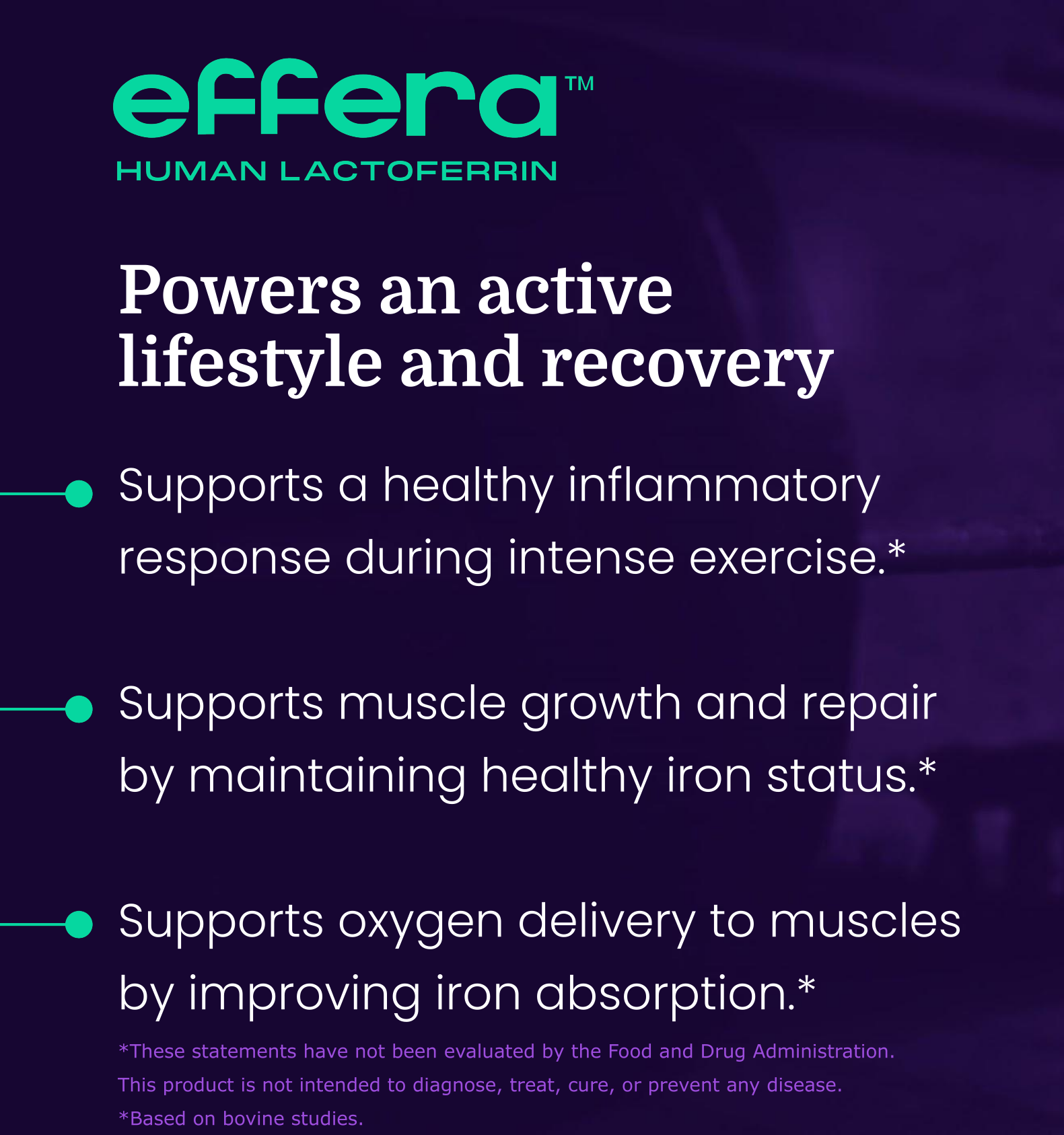
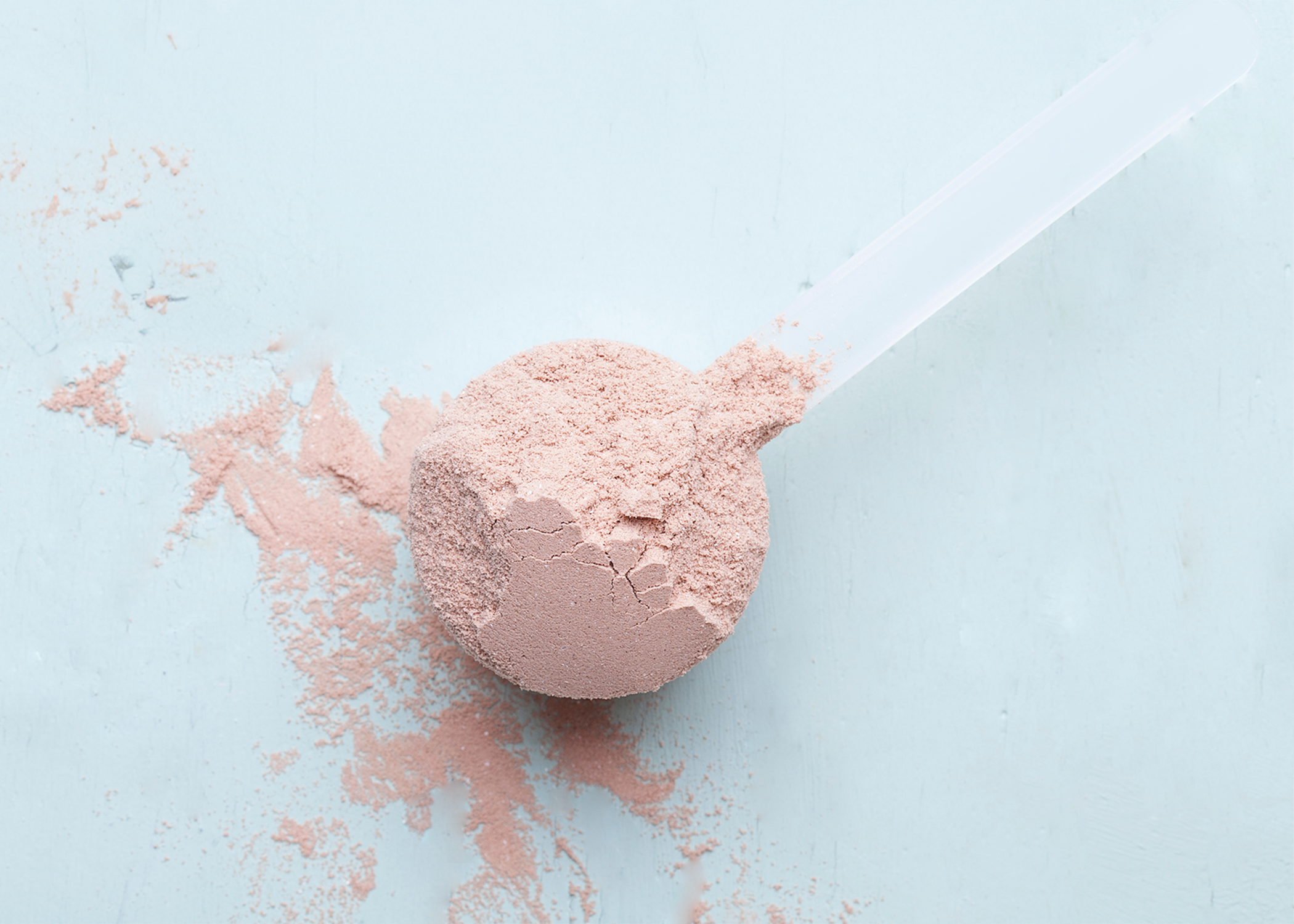
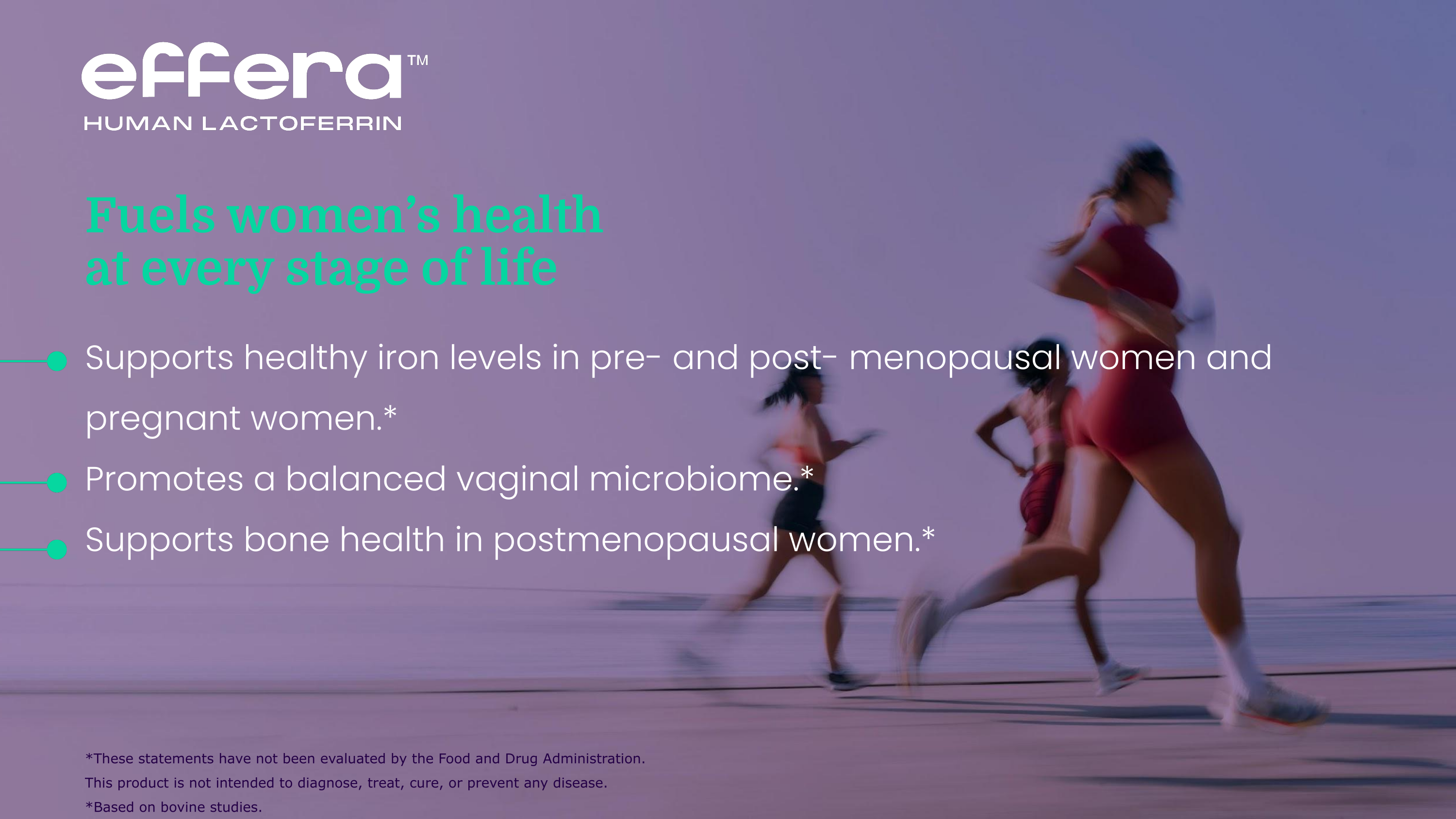
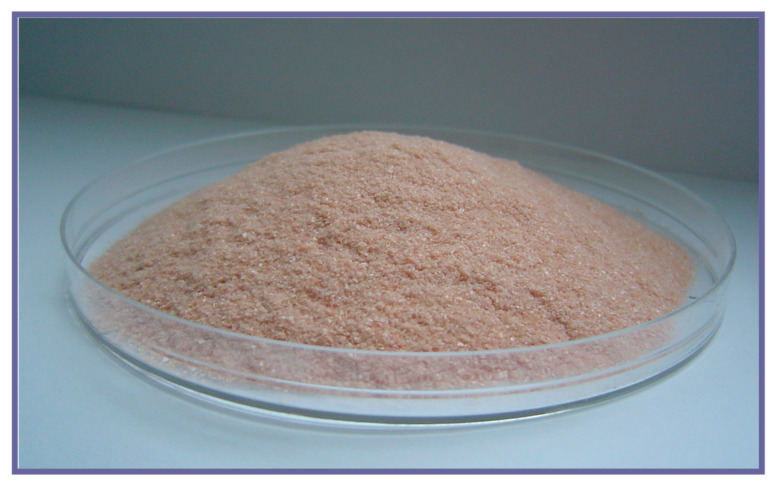
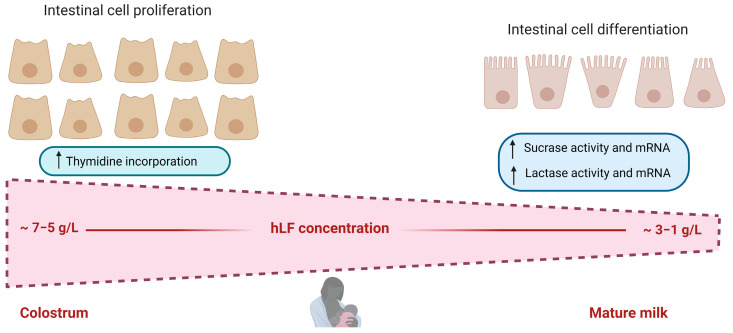

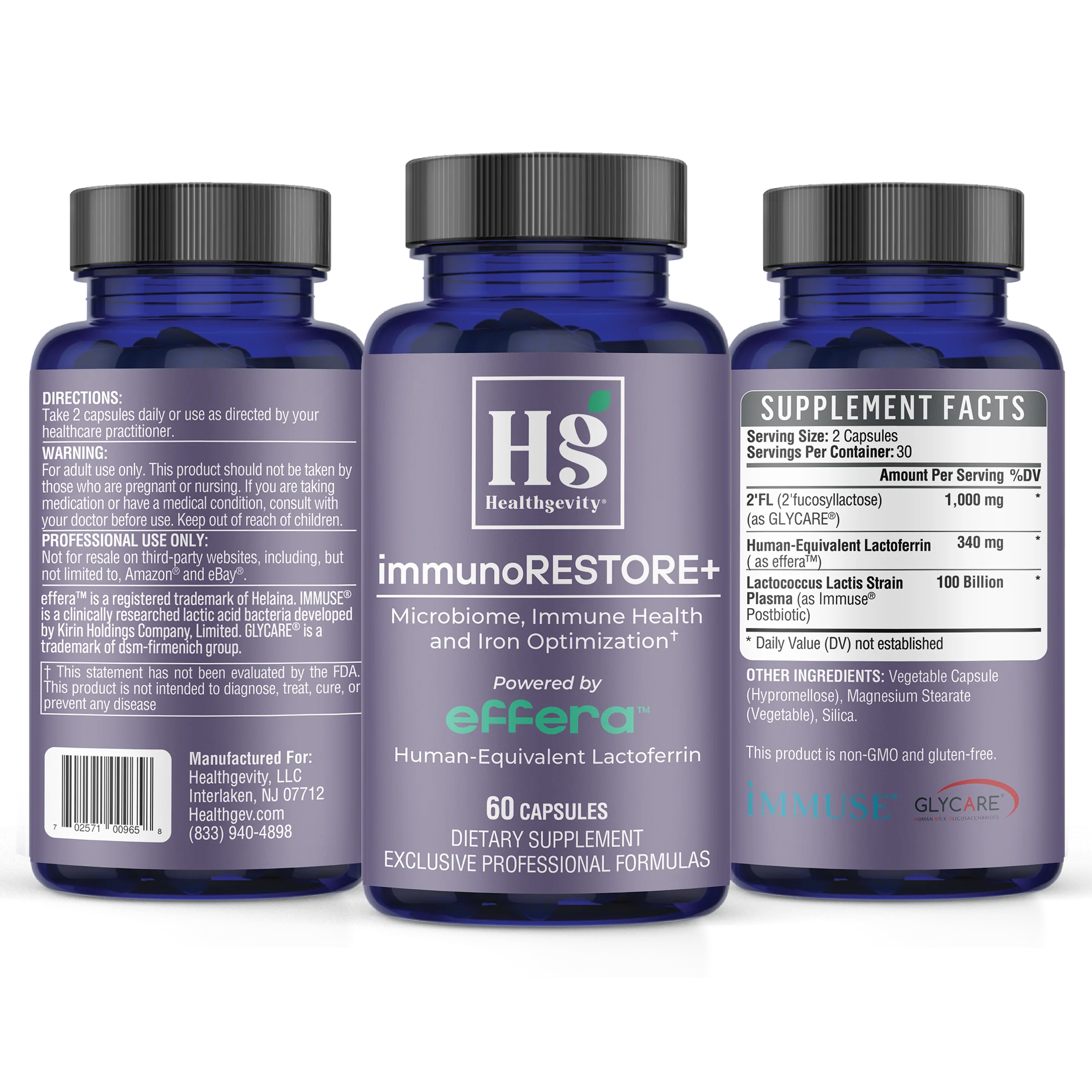



Comments and Discussion (Powered by the PricePlow Forum)